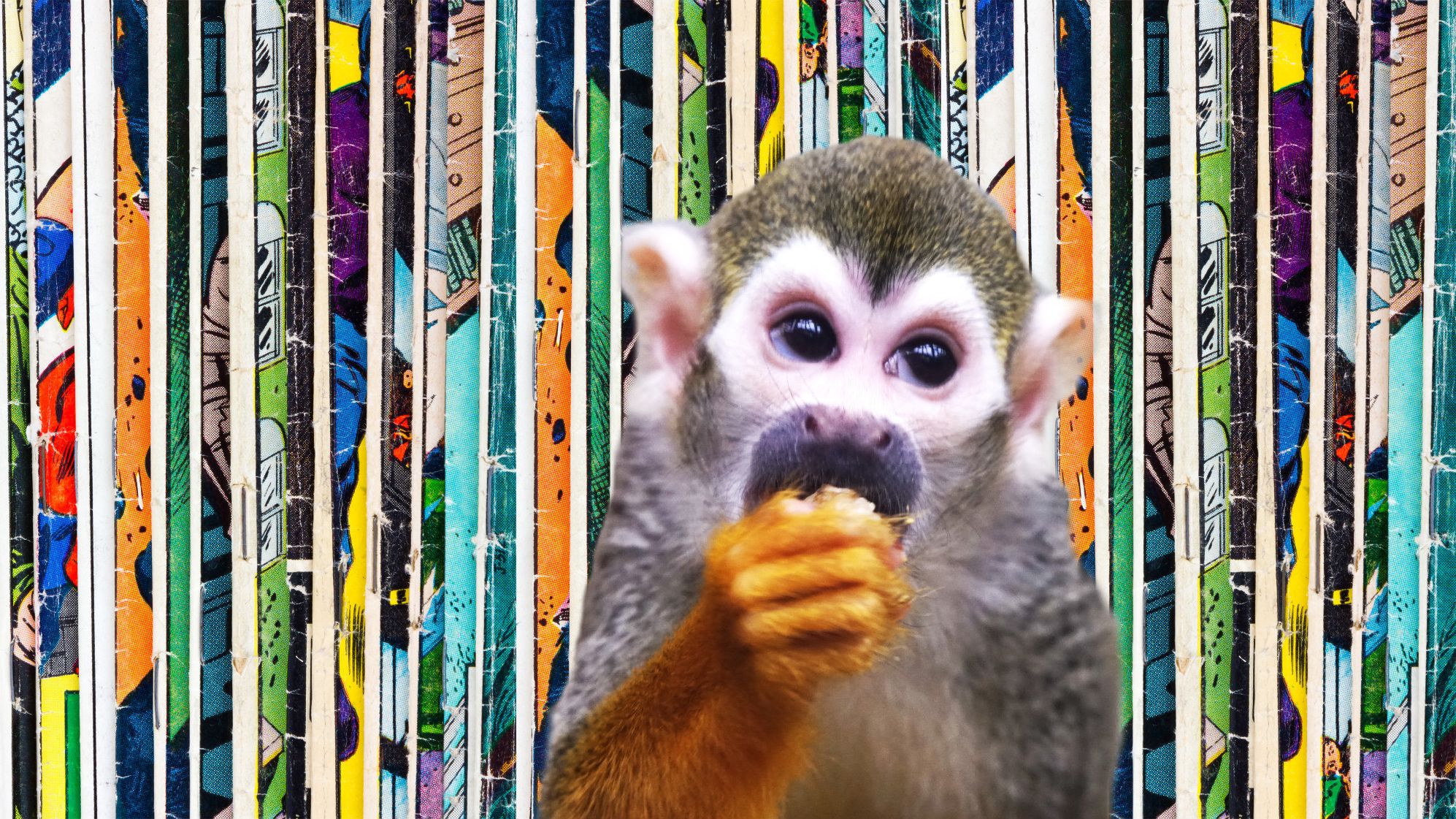
For comic book readers of the 1960s and beyond, the ads for mail-order items were sometimes just as intriguing as the superhero action they interrupted. X-ray goggles promised to make adolescents clandestine Peeping Toms; Charles Atlas vowed to turn slightly built kids into muscular powerhouses; most notably, Sea-Monkeys guaranteed a small packet of powder would bring aquatic life to your home. (They were well-marketed brine shrimp.)
Sea-Monkeys were far from the most outlandish attempt to solicit live animals to excitable children. That honor goes to the Animal Farm company of Miami Beach, Florida, which promised delivery of a genuine, live squirrel monkey to anyone sending them $18.95, plus postage due on delivery.
Monkey Business
In 2008, a man named Jeff Tuthill told ComicBookResources.com his sordid tale of a mail-order monkey mishap. As a kid in the early 1970s, Tuthill was reading a Spider-Man comic when he spotted an ad for a live monkey, which promised to bring “joy” to one’s household. To make sure his parents didn’t get wise, he had the primate delivered to a friend’s house.
“When he called, I rode over on my bike,” Tuthill said. “It came in this little cardboard box. I mean, I’m saying small. It was probably the size of a shoebox, except it was higher. It had a little chicken wire screen window in it. There was a cutout. All you could see if you looked in there was his face.”
Tuthill carried the monkey home and brought it to his basement, where he expected it to join his menagerie of rabbits and gerbils. Rather than settle in, the monkey began using the plumbing pipes as a jungle gym. When Tuthill grabbed it, the monkey began gnawing on his arm “like a drill press.”
A trip to the emergency room resulted in Tuthill receiving 28 stitches. Surprisingly, his parents allowed him to keep the monkey, which he named Chipper. Books and trial and error gave him some rudimentary knowledge of how to care for it. (Peanuts and seedless white grapes were appealing; bananas were not.) Chipper also enjoyed riding on the back of the family’s border collie, cowboy-style.
When Chipper was about 5 years old, he died suddenly. Tuthill suspected a possible wasp sting but could never be sure.
Swing Time
Chipper was a squirrel monkey, a popular species in the exotic pet trade that the National Resources Defense Council describes as needing an “insane” amount of care. Because they’re prone to destructive tendencies, few primatologists would ever advocate for keeping them in residential captivity. But in the 1960s and ’70s, a kind of squirrel monkey fever took hold; more than 173,000 of the animals were imported to the United States from Peru and Colombia, where they would then be sold via private dealers and comic or magazine ads, including the Warren horror publications like Creepy and Eerie. A number of dealers including Animal Farm peddled the primates. It was easy to fall for their tiny bodies and cartoonish, inquisitive expressions. One ad read:
“This Squirrel Monkey makes an adorable pet and companion. Almost human with its warm eyes, your family will love it. These young monkeys grow about 12 inches high. Eats same food as you, even likes lollipops; simple to care for and train. Live delivery guaranteed.”
None of the ads mentioned two common squirrel monkey traits: throwing feces and frequent masturbation. (Nonhuman primates are believed to practice self-love to eliminate low-quality sperm; the tossing of a turd might be out of frustration.)
In 2014, Tim Tate told NPR about how he and his brother Tom sent away for a comic book monkey in the mid-1960s. The animal arrived just as their mother’s bridge club was getting underway; Tate unboxed the monkey, which had been waiting to defecate while en route to its new home. It proceeded to jump out, poop everywhere, and then leap upon several members of the bridge club.
As the Tates rushed to contain the monkey—which they named Pepe—inside a crib, they were horrified to see their aunt reach her arm in between the bars of the bed, in an attempt to soothe the animal’s nerves.
“[B]ut where an arm can go in, a monkey can come out,” Tate said. “And out comes Pepe. And a monkey who believes he’s about to go to the next beyond in panic jumps out—and to escape, bites the first thing in front of his eyes. And what is that? That is my aunt’s pendulous breast.”
Pepe fled the scene, only to be found dead months later in a nearby forest. The Tates gave him a funeral procession in the box he was shipped in. Years later, their mother admitted the monkey had been spotted repeatedly in the neighborhood, but she hid any newspaper reports of the sightings from her sons. She didn’t want the monkey back in the house.
No Refunds
It’s impossible to estimate exactly how many mail-order monkeys were shipped to kids by the time the ads began to disappear from comic books in the late ’70s. Undoubtedly, many monkeys failed to survive transit, while others were abandoned or given away when their formidable demands for care became too much for kids and their parents.
Of course, it’s still possible to acquire a squirrel monkey. Just 18 states have laws barring their possession. According to the Primarily Primates rescue organization, a squirrel monkey can sell for close to $9000 via online channels. Then and now, monkeys are often given away when they begin to get aggressive or exhibit self-harming behavior. Regardless of how they’re acquired, it’s generally a bad idea to try and domesticate them—as the Tuthills, the Tates, and an untold number of other families discovered the hard way.
When Comic Books Sold Live Monkeys
Source: Philippines Wonders
0 Comments